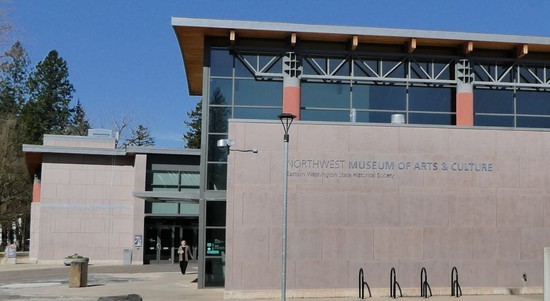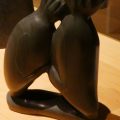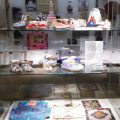
One gallery in the Northwest Museum of Arts and Culture in Spokane, Washington, is dedicated to The Secret Life of an Artifact. This display provides a behind-the-scenes at the museum collect and the science and creativity that goes in to preserving and interpreting artifacts. Textile arts, ranging from quilts to rugs, often dazzle the eye.

 Shown above is a crazy quilt from 1880-1920. This style of quilt was popular from the late nineteenth century into the early twentieth century. This type of quilt was often made for display.
Shown above is a crazy quilt from 1880-1920. This style of quilt was popular from the late nineteenth century into the early twentieth century. This type of quilt was often made for display.  Shown above is a tobacco novelty quilt which was popular from 1915-1920. The individual components of the quilt were originally incentives to entice people to buy cigarettes.
Shown above is a tobacco novelty quilt which was popular from 1915-1920. The individual components of the quilt were originally incentives to entice people to buy cigarettes.
According to the display:
“Tobacco companies initially offered cards to promote cigarette sales, but small pieces of fabric designed to appeal to women began to replace cards in the 1890s. Women used them to make decorative pieces like this one. The images on the fabric premiums became more elaborate after the break-up of the American Tobacco Company into competing smaller companies in 1911.”
 Shown above is a paisley shawl from 1860-1880.
Shown above is a paisley shawl from 1860-1880.
According to the display:
“Handwoven wool shawls from the Kashmir Valley were highly priced in England and France during the 18th century. British and French weavers copied them, although they continued to be made in India. These pieces became known as ‘paisley’ shawls when weavers in Paisley, Scotland, increased production by using a Jacquard mechanism on their looms.”
 Shown above is an overshot coverlet with a leaf pattern from 1800-1850. This was probably made in the eastern United States. ‘Overshot’ refers to the supplementary wool yarn that ‘overshoots’ a foundation of linen or cotton.
Shown above is an overshot coverlet with a leaf pattern from 1800-1850. This was probably made in the eastern United States. ‘Overshot’ refers to the supplementary wool yarn that ‘overshoots’ a foundation of linen or cotton.
Navajo Rugs
Navajo weaving is not just a way of making cloth or textiles: it is a form of artistic expression. The Navajo learned weaving from the Pueblo people in the 1600s. Weaving with cotton was common in the southwest prior to the arrival of the Spanish. After the arrival of the Spanish, the Navajo acquired churro sheep and began weaving with wool. The Navajo adopted the Pueblo weaving techniques with the vertical loom toward the end of the 17th century. In his book Native Arts of North America, Christian Feest reports:
“Within a short period of time they had become such superior weavers that by the early eighteenth century they were already selling their textiles to both Spanish and Pueblo communities.”
With regard to the designs used in Navajo weaving, Gary Witherspoon, in his book Language and Art in the Navajo Universe, writes:
“A weaver seldom, if ever repeats a design. Each rug woven is designed anew, so designs are always changing, flowing, moving.”
According to the display:
“Around the turn of the 20th century, Navajo weavers began to produce thick, elaborately designed rugs of brilliantly colored, hand-spun wool. The characteristic geometric patterns and beautiful, bright colors of this weaving style became known as the Eye Dazzler.”
 Shown above is an example of an Eye Dazzler Navajo rug.
Shown above is an example of an Eye Dazzler Navajo rug.
According to the display:
“Pieces like these were always meant for sale and were not used as ceremonial objects. Navajo weavers, who were almost always female, use a seemingly infinite variety of designs.”
Museums 101
Museums 101 is a series of photo tours of different museum exhibits. More from this series:
Museums 101: Quilts (Photo Diary)
Museums 101: The Weekly Newspaper (Photo Diary)
Museums 101: The Anderson Homestead Barn (Photo Diary)
Museums 101: The Fort Steele Drug Store (Photo Diary)
Museums 101: The Presby House Bedroom and Bathroom (Photo Diary)






Leave a Reply